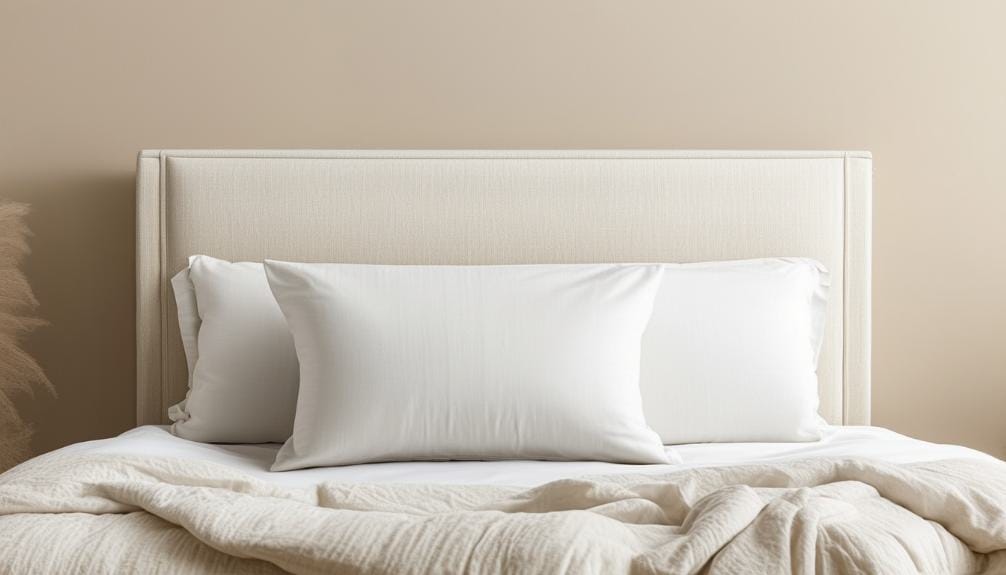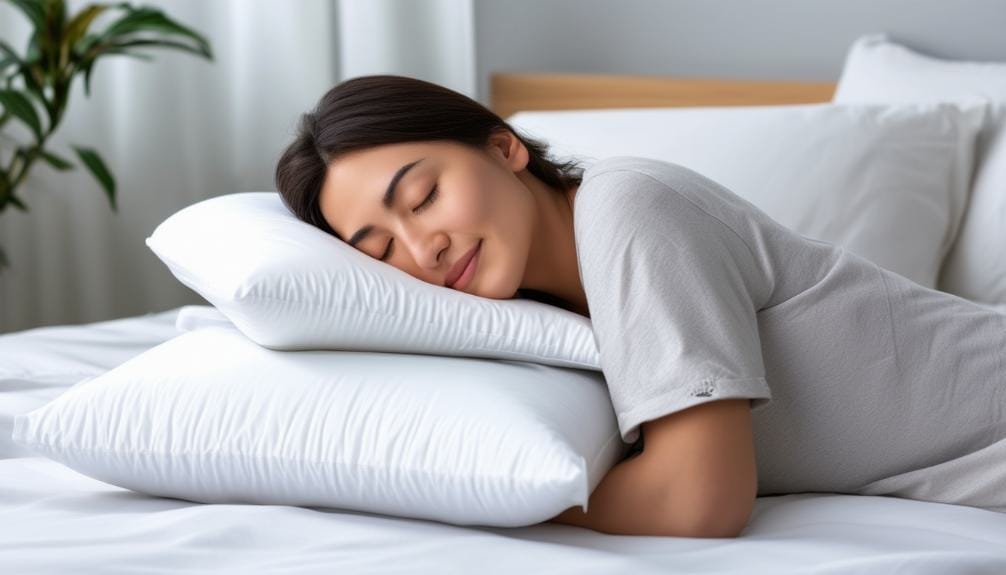Should I Get a Standard or Queen Pillow? A Guide to Choosing the Right Size
As you’re shopping for the perfect pillow, you’re faced with an important decision: standard or queen size? The right choice can greatly impact your sleep quality, but it’s not just about personal preference. Your bed size, sleeping position, and comfort needs all play a role in determining the ideal pillow size for you. You might be tempted to opt for the larger queen pillow, but will it really provide the support and comfort you need, or will a standard pillow suffice? The answer lies in grasping the unique benefits and drawbacks of each size, and that’s exactly what we’re about to explore.
Importance of Pillow Sizes
Pillow sizes play a crucial role in a restful night’s sleep. The right size provides necessary comfort and support, which in turn affects the quality of sleep. Choosing between a Standard and Queen pillow isn’t just about personal preference, but about finding the perfect fit for your bed and sleeping style.
Standard pillows are ideal for twin or double beds, while Queen pillows provide extra length for queen-sized beds. However, not everyone fits into these standard categories. This is where custom pillow sizes come into play, offering a tailored fit that caters to individual needs.
By considering pillow size options, you’re taking a crucial step towards better sleep quality.
It’s essential to compare pillow sizes to find the one that suits you best. A pillow that’s too small or too large can disrupt sleep patterns and cause discomfort. On the other hand, a pillow that’s tailored to your needs provides necessary support and comfort, leading to a more restful night’s sleep.
Pillow Size Options Explained
Pillow size options vary to accommodate different bed sizes and personal preferences. Standard pillows, measuring 20 x 26 inches, are ideal for twin or double beds. Queen pillows, slightly longer at 20 x 30 inches, fit queen beds perfectly. For king-sized beds, king pillows with dimensions of 20 x 36 inches are the best choice.
Considering bed size and personal comfort, pillow size comparison is crucial. A standard pillow provides a snug fit, while a queen pillow offers extra comfort. Notably, pillowcases labeled standard/queen size can fit both standard and queen pillows, offering flexibility.
Even king pillows can be used for decorative purposes on twin beds, adding style. By grasping pillow size options, you can make an informed decision that suits your needs. The right pillow size has a significant impact on sleep quality and overall comfort, as it provides the necessary support for a restful night’s sleep.
Standard Pillow Size Benefits

A standard pillow size, measuring 20 x 26 inches, offers a balanced fit for various sleeping positions and bed sizes, making it an ideal choice for twin or double beds. This size provides adequate support and comfort for most sleepers, fitting standard pillowcases easily without excess fabric.
The benefits of standard pillow size include:
| Benefits | Description |
|---|---|
| Versatile fit for sleepers | Accommodates various sleeping positions and bed sizes |
| Easy fit in pillowcases | No excess fabric, making it a convenient choice |
| Comfort and support | Provides adequate support and comfort for most sleepers |
| Ideal for smaller beds | Measures 20 x 26 inches, perfect for twin or double beds |
Standard pillow size is a practical choice for those who value a balanced fit and comfortable sleep. By considering pillow size preferences, individuals can make an informed decision that suits their needs.
Queen Pillow Size Advantages
Queen pillows provide an extra 4 inches of support compared to standard pillows, making them ideal for taller individuals or those who move around during sleep. This added length provides superior fit and comfort on queen-sized beds, where standard pillows often leave space uncovered. Although custom or super standard pillowcases may be required, the benefits of queen pillows outweigh the extra cost.
The versatility of queen pillows is a significant advantage. They can be used on twin, queen, or king-sized beds, making them a practical choice for upgrading sleeping comfort. By providing extra length and comfort, queen pillows promote better sleep quality. Assessing personal needs and preferences is crucial when comparing pillow sizes.
If extra length and comfort are priorities, a queen pillow is a superior option, offering superior support and coverage for a restful night’s sleep.
Queen pillows cater to individuals who require additional support and comfort during sleep. They provide extra coverage on larger beds, eliminating the need for multiple standard pillows. This results in a more comfortable and restful sleeping experience. By choosing a queen pillow, individuals can enjoy a superior sleeping experience tailored to their specific needs.
King and Euro Square Pillows

Upgrading your bedding can greatly benefit from considering king and Euro square pillows, each offering distinct advantages and features that can significantly impact your sleeping experience.
Measuring 20 x 36 inches, king pillows provide an expansive surface area, lending comfort and support to sleepers. Their longer length makes them ideal for restless sleepers, as they can accommodate both King and Queen beds, offering back support while sitting or sleeping. The benefits of king pillows are twofold, providing extra comfort and support for your neck and shoulders.
In contrast, Euro square pillows, typically sized 26 x 26 inches, primarily serve a decorative purpose. Originating from Europe, they add a touch of elegance and sophistication to your bed, giving it a luxurious appearance. Although they may not provide the same level of support as king pillows, they can complement your bedding, creating a cozy atmosphere.
Ultimately, the decision between king and Euro square pillows hinges on your personal preferences, sleeping habits, bed size, and desired level of support.
Body Pillow Size and Uses
A body pillow’s generous size, typically measuring 20 x 54 inches, provides full-body support for a restful night’s sleep. Designed to run the length of your mattress, these pillows offer extensive comfort and support from head to toe. Side sleepers benefit from the extra support and pressure relief, which alleviates strain on shoulders and hips.
Pregnant women appreciate the comfort and support, which helps alleviate back pain and promotes a restful night’s sleep. Proper alignment and reduced pressure points result from using a body pillow, leading to improved overall sleep quality.
Compared to standard, queen, or king pillows, body pillows offer more support and comfort, making them an excellent choice for anyone seeking a more restful and rejuvenating sleep experience.
Mixing Pillow Sizes for Comfort

Mixing pillow sizes can significantly impact the quality of your sleep. By combining different pillow sizes, you can create a personalized sleep setup that addresses your unique comfort needs and preferences.
Combining different pillow sizes caters to individual preferences by providing varying support and alignment for better sleep. This leads to waking up feeling rested and refreshed.
A layered pillow arrangement can add visual appeal to your bed, creating a cozy and inviting atmosphere. Using a combination of standard and queen pillows strikes a balance between aesthetics and functionality, allowing you to create a sleep setup that’s both comfortable and visually pleasing.
Experimenting with pillow sizes allows you to customize and personalize your bedding, meeting your unique pillow size preferences and needs for personalized comfort. This customization leads to a more comfortable sleeping experience, which is essential for overall well-being.
Pillow Size and Bed Type
Pillow size directly correlates with bed type, making it crucial to match the two for optimal comfort and support. A twin or double bed requires a standard pillow (20 x 26 inches) to provide the right fit, while a queen-sized bed necessitates a queen pillow (20 x 30 inches) for a comfortable night’s sleep.
Bed compatibility is vital because a mismatched pillow size can compromise comfort, disrupt the room’s aesthetic, and negatively impact sleep quality. A queen pillow on a twin bed, for instance, appears out of place, whereas a king pillow on a queen bed can create a cozy atmosphere.
To achieve the perfect balance of comfort and style, it’s essential to consider the bed type and corresponding pillow size. This consideration guarantees a restful night’s sleep and a visually appealing bedroom.
A well-matched pillow size and bed type create a harmonious sleep environment that promotes better sleep quality and a more inviting bedroom ambiance.
Choosing the Perfect Pillow Size

Choosing the perfect pillow size is crucial for a restful night’s sleep. Your personal comfort preferences and sleeping habits dictate the ideal fit. A pillow that provides the right amount of support and comfort is vital for your unique needs.
To determine the right pillow size, consider these key factors:
- Sleeping position affects pillow size: Side sleepers need a thicker pillow to fill the gap between their ear and shoulder. Back sleepers prefer a thinner pillow, while stomach sleepers require a very thin one.
- Body type influences pillow size: Larger individuals benefit from queen or king pillows for extra support, while smaller individuals find standard pillows sufficient.
- Pillow loft matters: If you prefer a lot of loft, a queen or king pillow is the way to go. If you prefer a lower profile, a standard pillow is best.
- Compare pillow sizes to your bed and current pillows: If you’re used to sleeping on a standard pillow, try a queen pillow for extra comfort. Consider the size of your bed and the pillows you already use to find the perfect fit.
Frequently Asked Questions
Can I Use a Standard Pillow on a Queen-Sized Bed?
You can use a standard pillow on a queen-sized bed, but consider your back support needs and bed size – a standard pillow might not provide enough support or fit snugly, leaving a slight overhang.
Do Queen Pillows Work Well for Back Sleepers?
You’ll find that queen pillows work amazingly well for back sleepers, providing extra length for excellent neck support and comfort. However, as a side sleeper, you might prefer a standard pillow size for better alignment.
Are Queen Pillows Too Big for Small-Framed Individuals?
You’ll find that queen pillows are likely too big for you if you’re small-framed, as they can overwhelm your bed space and make it hard to get comfortable with the added pillow thickness.
Can I Fold a Queen Pillow to Fit a Standard Pillowcase?
You can’t fold a queen pillow to fit a standard pillowcase without compromising its shape and support; instead, choose a queen-sized pillowcase for a proper fit, considering your size preferences and comfort levels.
Do Pillow Sizes Vary Between Brands and Manufacturers?
You’ll find that pillow sizes can differ between brands and manufacturers, resulting in variations in dimensions, so it’s essential to check the specs when buying, as brand-specific pillow size differences can impact your comfort.
Conclusion
You’ve weighed the pros and cons, and now it’s time to make a decision. Remember, your pillow size should align with your sleep needs and bed size for best comfort and quality rest.
If you’re still unsure, consider your sleeping habits, personal preferences, and the size of your bed. By choosing the right pillow size, you’ll be sleeping better in no time.
So, go ahead and pick the perfect pillow size for a restful night’s sleep.
